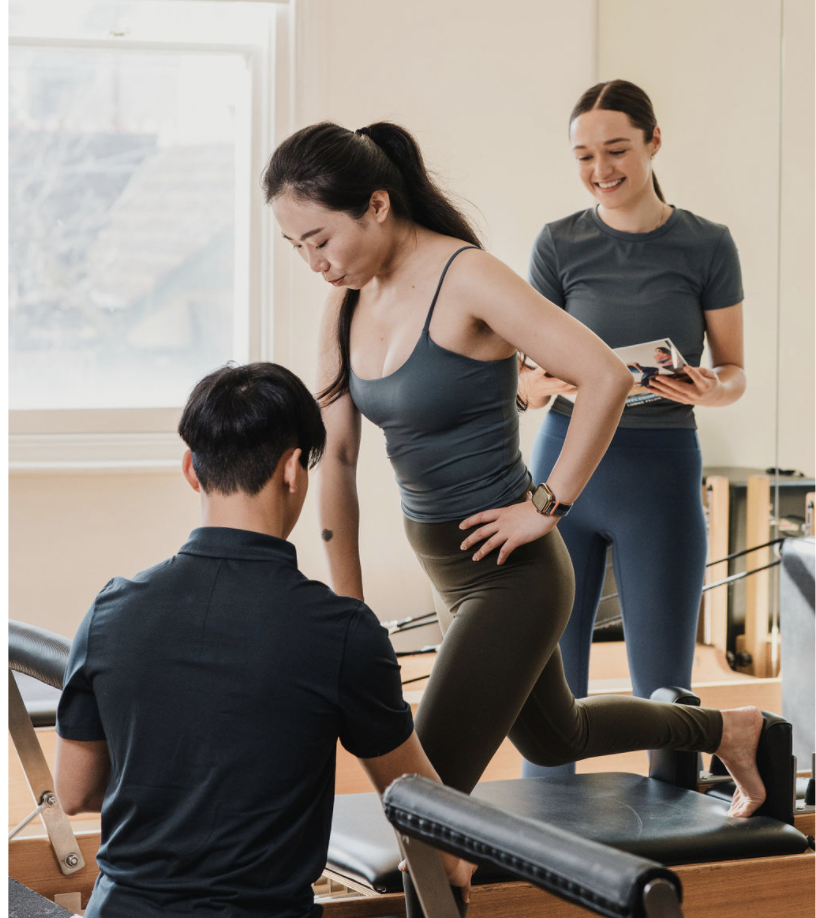APPI Clinical Pilates for an Achilles Tendon Injury.
Anatomy and Function
The achilles tendon is possibly the most important tendon for human function. It is the strongest and thickest tendon in the body combining the tendons of the soleus and gastrocnemius and serving as an attachment point for the plantaris muscle (termed triceps surea).
The triceps surae raises the heel and lowers the forefoot (plantar flexion), contributes to shock absorbance of the foot and supports tensional forces produced by movement of the lower limb. Transmitting power from the calf muscles to the heel and the foot. You might be able to walk without your achilles, but you sure can’t run. Think of yourself as a catapult and the Achilles’ tendon part of the rubber band.
Pathology
The two most common injuries of the achilles tendon are tendinopathy and rupture, both complete and partial. Consider how a catapult might get a bit stretched out of shape with repetitive and less than ideal load, perhaps being pulled from the wrong angle. Think of all the different options we have of using our feet and lower limb to achieve forward motion.
Achilles Tendon Complete Rupture
This injury would be managed surgically and involve an extensive rehab program. Sarah the founder of Unite Health experienced this first hand and will be sharing her story for everyone.
Achilles Tendon Partial Rupture
This injury may or may not be managed surgically, in the below case study the Achilles tendon had a partial rupture less than 50% which has been shown to have success with conservative management.
Achilles Tendinopathy
The definition of Tendinopathy is a failed healing response of the tendon, with a cascade of abnormalities in the cells and fibres. The term tendinopathy is a generic descriptor of the clinical conditions associated with overuse in and around tendons.
Rehab focus for tendinopathy has been on gradual increased eccentric loading of the tendon. The load created by springs on Pilates equipment is too variable during the early stages of rehab (similar to a jump which tendons don’t like early on) and may be too light for rehab further down the track. End stage rehab may benefit from the plyometric work that can be created using jump boards on reformers. Clients with achilles tendinopathy would benefit from Pilates to address imbalances and support the rest of their body during recovery.
Refer to Jill Cook research for further information. This is a useful clip for your clients regarding tendinopathy https://youtu.be/Hkb-O3PshcM
Case Study: Achilles Tendon Partial Rupture
35 yr old female trail runner who felt acute pain in left calf whilst running through uneven terrain. MRI showed partial tear Achilles’ tendon - approximately 40%. Client preferred to opt for non-surgical management.
Program
Pilates alongside eccentric load training indicated for partial rupture as over 50% tendon intact. The Pilates repertoire supports the weakened triceps surae complex.
Week 3-6
APPI Toes - foot series
Using a jump board to limit excess plantar flexion.
APPI Reformer Heels
For lower limb alignment and motor control work.
APPI Reformer Side plies
Modified with leg straight and a heal raise whilst also working lateral gluts and maintaining optimal positioning of the pelvis. Watch our short video below to demonstrate.
APPI SPC Ankle Exercise
The bent knee favours soleus, loaded to work the muscle eccentrically. Watch our short video below to demonstrate.
APPI Reformer Side splits - Abduction and Adduction
Neutral foot position with focus on lateral pelvic stabilisers and adductors to support balanced lower limb biomechanics.
Theraband - resisted dorsiflexion and plantar flexion and inversion and eversion - isolated work on the individual movements of the ankle. Using the different muscles (tibias posterior etc) to support the achilles and gastrocnemius and soleus in their function.
Plantar Fascia release with a spikey ball to encourage blood flow and reduce tightness through this area.
Proprioceptive work - encourage weight-bear with 3 points of contact. The base of the 1st and 5th metatarsal and the front of the heel.
Foot mobility, supination and pronation. At the rear foot, supination involves dorsiflexion, inversion and external rotation and pronation involves plantar flexion, eversion and internal rotation. Considering the attachment points of the tendon onto the calcaneum, inversion and eversion will also tension the tendon. Supination and pronation involves the whole foot so practicing these movements with the 3 points of contact with the ground will encourage the natural movement of the 26 joints of each foot.
Whole body conditioning. Limited thoracic extension was identified on assessment and may have impacted good running form. Working on pelvis and torso motor control with upper limb supported the lower limb rehab.
Week 6-10
Added eccentric body weight calf raises increasing to higher load using gym based weights.
Week 10-12
Added plyometrics
APPI Hops and jumps side lie - challenging the tendon into more variable load whilst remaining supported with the reformer.
APPI Standing leg press - work on standing single leg control with more plantar flexion at the ankle.
Run technique - addressing mobility in feet, pelvis, spine and rib cage alongside single leg work.
Outcome
She returned to trail running around 3 months post-injury with a gradual increase in distance.
When creating a pilates program clinically reason using anatomy, biomechanics, pathology and the individual.
Upskill with Clinical Pilates
The APPI (Australian Physiotherapy & Pilates Institute) Clinical Pilates Teacher Training Courses have been designed by Physiotherapists specifically for Physiotherapists and allied health professionals. The training will equip you with the skills and knowledge to further assist clients in their health and rehabilitation goals using clinically-safe Pilates techniques.
Choose your pathway to become a Clinical Pilates Teacher here
References
Clinical Sports Medicine 3rd Edition, Peter Brukner and Karim Khan
Physiopedia
